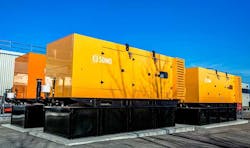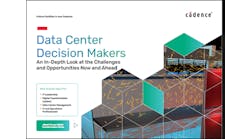When you think “hyperscale data centers,” you may not think of Montreal. But AJ Byers does.
Byers is the President and CEO of ROOT Data Center, which is helping establish the province of Quebec as a destination for some of the world’s largest Internet companies. Byers saw an opportunity to leverage Quebec’s ample supply of cheap hydroelectric power, along with a rapid-deployment data center design developed by ROOT founder and COO Jason Van Gaal.
“We decided to target some of the biggest tech companies in the world,” said Byers. “They were shockingly interested in our speed-to-build.”
ROOT quickly notched a big win, landing a marquee tech company that is leasing space within the company’s original 5 megawatt facility in Montreal, and serving as the anchor tenant in a massive 50 megawatt data center. The anchor tenant has already deployed 10 megawatts of capacity with ROOT, which is preparing the next 10 megawatt phase.
Byers declines to name the tenant. Google has spoken in the media about deploying a cloud region in Montreal, as well as an artificial intelligence research institute that is working closely with local universities on innovation in AI. Amazon Web Services also recently opened its first Canadian region in Montreal.
Cheap Green Power and Fast Deployment
In building its business in Montreal, ROOT is riding a confluence of trends, including hyperscalers’ appetite for cheap power and rapid deployment of capacity. The company is also capitalizing on growing interest in Canada, driven by both local and global concerns about data residency.
On the data residency front, having a physical facility in Canada is critical to winning government IT business. Last year the Canadian government released a cloud adoption plan which restricts storage of sensitive data to facilities located within Canada. It’s one of a number of countries focused on retaining data within national borders, driven by concern about revelations of NSA surveillance programs. This has prompted cloud providers to deploy in-country infrastructure in more locations.
“Data residency is still critical, and if you want to deal with government and the financials and healthcare sectors, they want their data to be in-country,” said Byers.
Toronto or Montreal?
In Canada, that has meant a growth in data center development in Toronto and Montreal. Toronto is the nation’s financial capital, and home to the largest concentration of enteprise IT business. Companies like Q9 Networks, Equinix and Cologix have built colocation businesses in Toronto, and last year DuPont Fabros Technology became the first of the major U.S. data center REITs to push into Toronto.
“There are still a lot of people betting on Toronto,” said Byers, who thinks the real action is to the East in Quebec, where Hydro Quebec has invested heavily in building hydro-electric dams and generation, which supply 95 percent of the province’s power, with wind and other renewables providing the remaining 5 percent.
This abundant hydro power is available at far cheaper prices than options in Toronto. Hydro Quebec offered an average power rate of just 5.2 cents per kW in 2016, according to site selection specialist JLL, compared to the 10.3 cents per kW in Toronto. Hydro Quebec touts rates for data centers as low as 2.48 cents, which would be equivalent with the most affordable U.S. power in Quincy, Washington (which is also supported to utility-scale hydro-electric generation).
“By Canadian standards, Ontario’s electricity is ridiculously expensive,” The Toronto Globe and Mail wrote in a recent analysis. “The province’s two Canadian neighbours – Quebec and Manitoba – enjoy electricity prices that are about half what Ontario pays.”
A Kyoto Cooling “heat wheel” inside a ROOT Data Center facility in Montreal. (Photo: ROOT Data Center)
ROOT was founded in 2014 by Van Gaal, an entrepreneur who began his career in data center design and then in 2011 founded Granite Networks, a colocation provider that was acquired by Rogers. In creating ROOT’s first data center in the Montreal borough of LaSalle, Van Gaal was an early adopter in bringing Kyoto Cooling into multi-tenant data center facilities. On its market entry, ROOT also focused on disruptive pricing that offered “retail (colocation) at wholesale pricing.”
In 2015, Byers joined the ROOT team. Byers had extensive experience managing data centers for Canadian telecoms Primus and Rogers. Like Van Gaal, he had founded a data center company (BLACKIRON Data) that was later acquired by Rogers.
Byers retooled the company’s narrative away from low pricing to focus on ROOT’s infrastructure and design. He also wanted to broaden the company’s sales horizon. “For years, every provider was focused on ‘enterprise Canada.'” he said. “Nobody looked at the possibility that we would have a large influx of large hyperscale providers.”
A key selling point is ROOT’s ability to deploy capacity quickly. ” We can deploy a 5 megawatt modular build, with a 3 megawatt IT yield, in 90 to 120 days,” said Byers. ROOT’s data halls are sized at 10,000 to 12,000 square feet, and are supported by multiple “lineups” of 500kW UPS and generator. Cooling is provided by Kyoto Cooling units located along exterior walls of the data hall.
Supporting 40kW per Rack
The Kyoto Cooling heat wheel eliminates the need for chillers in most operating conditions, but offers advantages over direct fresh air cooling, eliminating risk from contamination and humidity. As the wheel spins between two compartments, the ambient air cools the wheel, and then the wheel cools the supply air for the data center. The two airflows never meet or mix. The system can work without water, which reduces a data center’s impact on the local utility infrastructure.
Server cabinets inside a ROOT data center near Montreal. (Photo: ROOT Data Center)
ROOT’s design uses air to cool high-density racks featuring up to 40kW per rack of power. Its design features full hot aisle containment, with several refinements, including a redesigned mesh door to allow more airflow into the rack, and a fanatical focus on sealing every crevice around the rack to maintain proper airflow.
With an anchor tenant on board, ROOT built its MTL-R2 data center in Baie d’Urfé, a Western suburb of Montreal. It’s not the only cloud provider in the area, as French hosting giant OVH operates its main North American data center just across Lac St.-Louis in Beauharnois, Quebec.
Byers said having a marquee anchor tenant has helped ROOT’s growth trajectory. “They’ve boosted our ability to fund our growth and mature very quickly,” said Byers. “We are very focused on supply chain, and we like to have vendors hold inventory for us. They really want to support our tenant.”
Many of ROOT’s customers are Montreal-area businesses that require colocation space for their business IT needs. That includes technology businesses leveraging ROOT’s high-density hosting capabilities, including gaming companies, AI firms, and post-production “render farms” creating computer-generated special effects for movies and television.
The Road Ahead
ROOT has plenty of expansion capacity in Montreal. “There will be more runway and additional facilities at our current campus,” said Byers, noting that the campus is 2,000 feet from the largest electric substation in Montreal.
ROOT is also considering expansion strategies, although not in the American market. “My general view of the US is that it’s pretty saturated,” said Byers. Another market in Canada is an option, but Byers is thinking internationally.
“There’s no other compelling location in Canada that can drive the same kind of cost savings,” said Byers. “Our more interesting path is to find other parts of the world that have those same attributes. It’s about finding regions with the right form factor for cloud growth. There’s so much capacity in the US that it’s a no-brainer to build there. There’s a smaller group of us looking at second-tier markets in international markets.”






